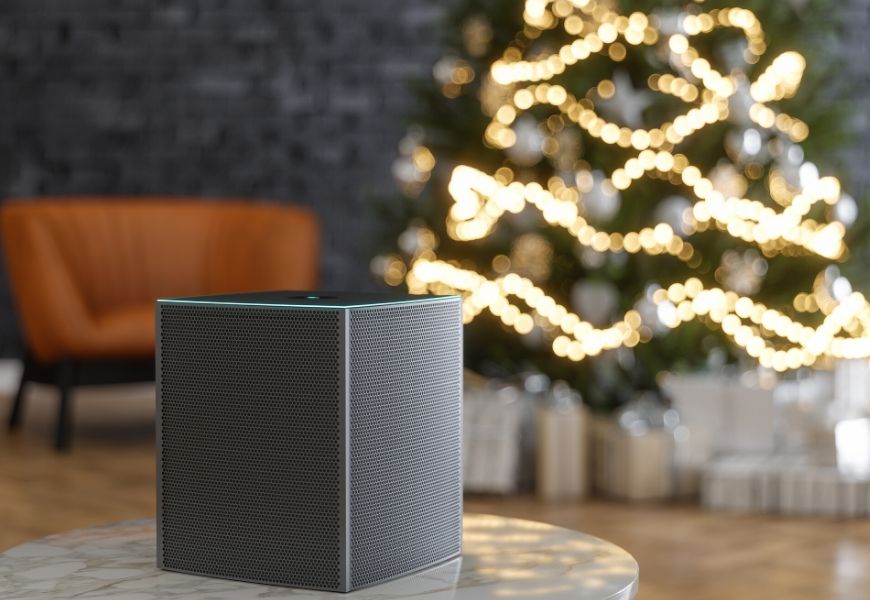
Tech the halls with connected devices this Christmas
It’s the time of year often dubbed the ‘silly season’.
Yet, the lead up to Christmas and its jolly aftermath may soon become known as the ‘smart season’ instead as Aussies ramp up the smart tech cheer.
Far from being ‘bah humbug’, the average number of connected devices in Australian homes is estimated to grow from 18 this year to 21 in 2020. That’s according to Foad Fadaghi, Managing Director at Telsyte.
Additional data from Telsyte, a technology analyst firm, suggests the booming Internet of Things trend – the tech movement towards converting once-idle items into connected devices – is set to further explode like a Christmas cracker!
Why? Because those 21 connected devices expected in 2020 are set to soar like Santa’s reindeer to more than 37 connected devices by 2023, transforming the $1.1 billion industry (2018) into $5.3 billion in Australia in that same year.

Data for dinner
That average number of connected devices per home translates to a whopping total of 186 million this year, with a total of 212 million expected in 2020.
And at the top of the wish list for good boys and girls of all ages is the smart speaker.
One in five Aussie households are anticipating festively furnishing their homes with this sound gift idea. There’s also a big push towards wearables and smart appliances this festive season, with the latter gift category looking bright beyond Christmas.
By 2023, smart appliances – like smart fridges, smart washing machines and smart coffee machines – are expected to comprise 41 per cent of all appliance sale revenue.*

With all of these connected devices using data, this year is already shaping up to be as busy as the supermarket carpark on Christmas Eve.
“Based on previous trends and coupled with smart tech becoming the new norm,” says Ray Owen, Chief Technology Officer at NBN Co, “we anticipate there will be more data consumed this Christmas than ever before.”
Roast turkey, plum pudding and an extra big helping of broadband.
Sleighing on top of demand
More connected devices in the home means a greater need for high-speed broadband.
Given a big part of happy holidays is streaming entertainment (and eating Christmas leftovers), we’re anticipating a spike in data consumption.
After all, it’s not just the data needs of everyday connectivity and smart device gifts to consider – visiting family and friends tend to arrive with connected devices too.
Traditionally, Boxing Day is the busiest for traffic on services over the nbn™ broadband access network.
A data-heavy mix of, perhaps, streaming the Boxing Day Test, shopping the Boxing Day Sales online, and wishing family and friends in the northern hemisphere a very merry Christmas by video call.†
Last year, the day-to-recover-from-Christmas saw an average of 11.8GB of data consumed per household on active services on the nbn™ access network across Australia, a massive 69 per cent increase on the daily average of 6.98GB per household.‡

Managing the Christmas load
The modern-day equivalent of forgetting to buy batteries for that new toy eagerly opened on Christmas morning, the last thing you want to worry about over the break is a poor broadband experience.
Ahead of the holidays, says Owen, why not make some quick checks to help optimise your in-home broadband setup.
Get ready for the big-data needs of December so you can focus on the festivities:
- Match your router to your needs. Like a new pair of festive-themed socks and matching tie, a Wi-Fi router works best when it matches the networking needs of your home. If you live in a gaming household, for instance, purchase a gaming-focused router to help keep up with demand. Similarly, if you live in a large house, consider buying a wireless mesh router to help keep the Wi-Fi signal strong throughout your home.
- Keep your modem central and free. The flashing lights of your Wi-Fi router/modem might not be as pretty as your Christmas tree, but keeping that critical piece of networking equipment free of obstruction and in a central location gives it the best chance to operate effectively. Keep the heart of your home network away from obstructions like pillars, as well as household items that can cause interference like TVs, ovens and hot-water systems.
- Check the speed of your plan. For a speedy little Christmas like Dasher, chat with your phone and internet provider about your internet habits, then ask if your current speed plan over the nbn™ access network is up to task. Ultimately, you want a retail plan that matches your internet habits, keeps up with the number of connected devices in your home, and is capable of servicing the number of people who need to be online at the same time.
* The figures for connected devices throughout this blog are from the Telsyte Australian IoT@Home Market Study 2019.
† An end user’s experience, including the speeds actually achieved over the nbn™ broadband access network, depends on the nbn™ access network technology and configuration over which services are delivered to their premises, whether they are using the internet during the busy period (typically, 7pm to 11pm), and some factors outside of NBN Co’s control (like their equipment quality, software, chosen broadband plan, signal reception, or how their provider designs its network). Speeds may also be impacted by the number of concurrent users on the Fixed Wireless network, particularly during busy periods. Sky Muster™ satellite users may experience latency.
‡ Average refers to 2018 June-Nov daily average per active service.
